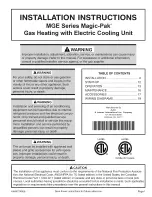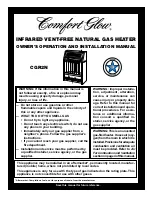
4 Assembly and connection
Rittal air/water heat exchanger assembly instructions
11
EN
Fig. 11:
Lay the cooling water hose
4.5.1 Notes on water quality
To ensure the reliable operation of the above-men-
tioned units, the VBG guidelines for cooling water
must be observed (VGB-R 455 P).
The cooling water must not contain any limescale de-
posits or loose debris; in other words, it should have
a low level of hardness, in particular, a low level of
calcium hardness. In particular, for recooling within
the plant, the calcium hardness should not be too
high. On the other hand, the water should not be so
soft that it attacks the materials. When recooling the
cooling water, the salt content should not be allowed
to increase excessively due to the evaporation of
large quantities of water, since electrical conductivi-
ty increases as the concentration of dissolved sub-
stances rises, and the water thereby becomes more
corrosive.
• Always add the appropriate volume of fresh water.
• Always remove part of the enriched water.
The following criteria for the cooling water must be
observed:
– Water with high gypsum content is unsuitable for
cooling purposes because it has a tendency to
form boiler scale that is particularly difficult to re-
move.
– The cooling water should be free from iron and
manganese, because otherwise deposits may oc-
cur that accumulate in the pipes and block them.
– At best, organic substances should only be
present in small quantities, because otherwise
sludge deposits and microbiological contamina-
tion may occur.
4.6 Notes on electrical installation
When performing the electrical installation, it is im-
portant to observe all valid national and regional reg-
ulations as well as the provisions of the responsible
power supply company. The electrical installation
may only be performed by a qualified electrician who
is responsible for compliance with the applicable
standards and regulations.
4.6.1 Connection data
– The connected voltage and frequency must corre-
spond to the values stated on the rating plate.
– The air/water heat exchanger must be connected
to the mains via an all-pin isolating device that
ensures at least 3 mm contact opening when
switched off.
– No additional temperature control may be con-
nected upstream of the unit at the supply end.
– Install the pre-fuse specified on the rating plate
(miniature circuit-breaker “K” characteristic or slow
fuse) to protect the cable and equipment from
short-circuits.
– The mains connection must ensure low-noise
potential equalisation.
4.6.2 Overvoltage protection
and supply line load
– The unit does not have its own overvoltage protec-
tion. Measures must be taken by the operator at
the supply end to ensure effective lightning and
overvoltage protection. The mains voltage must
not exceed a tolerance of ±10%.
– In accordance with IEC 61 000-3-11, the unit is
intended solely for use at sites with a continuous
current-carrying capacity (incoming mains power
supply) of more than 100 A per phase and with
a supply voltage of 400/230 V. If necessary, the
power supply company must be consulted to en-
sure that the continuous current-carrying capacity
at the point of connection to the public grid is
sufficient for connection of such a unit.
– The fans in single- and three-phase units are intrin-
sically safe (thermal winding protection). The same
also applies to all transformer versions and to spe-
cial-voltage units which are likewise equipped with
a transformer.
– Install the slow pre-fuse specified on the rating
plate (miniature circuit-breaker with “K” character-
istic, motor circuit-breaker or transformer circuit-
breaker) to protect the cable and equipment from
short-circuits. Select a suitable motor circuit-
breaker/transformer circuit-breaker in accordance
with the information specified on the rating plate:
Set it to the minimum specified value. This will
achieve the best short-circuit protection for cables
and equipment. Example: Specified setting range
MS/TS 6.3 – 10 A; set to 6.3 A.
Summary of Contents for SK 3209. Series
Page 2: ......












































